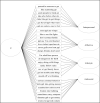Examining the Factor Structure of the Self-Report of Psychopathy Short-Form Across Four Young Adult Samples
- PMID: 27052364
- PMCID: PMC5053911
- DOI: 10.1177/1073191116640355
Examining the Factor Structure of the Self-Report of Psychopathy Short-Form Across Four Young Adult Samples
Abstract
Psychopathy refers to a range of complex behaviors and personality traits, including callousness and antisocial behavior, typically studied in criminal populations. Recent studies have used self-reports to examine psychopathic traits among noncriminal samples. The goal of the current study was to examine the underlying factor structure of the Self-Report of Psychopathy Scale-Short Form (SRP-SF) across complementary samples and examine the impact of gender on factor structure. We examined the structure of the SRP-SF among 2,554 young adults from three undergraduate samples and a high-risk young adult sample. Using confirmatory factor analysis, a four-correlated factor model and a four-bifactor model showed good fit to the data. Evidence of weak invariance was found for both models across gender. These findings highlight that the SRP-SF is a useful measure of low-level psychopathic traits in noncriminal samples, although the underlying factor structure may not fully translate across men and women.
Keywords: antisocial behavior; bifactor; gender; invariance; psychometric; sample.
Figures


Similar articles
-
Assessing Psychopathic Traits and Criminal Behavior in a Young Adult Female Community Sample Using the Self-Report Psychopathy Scale.J Forensic Sci. 2015 Jul;60(4):928-35. doi: 10.1111/1556-4029.12783. Epub 2015 Apr 21. J Forensic Sci. 2015. PMID: 25899444
-
An examination of gender-moderated test bias on the Levenson Self-Report Psychopathy Scale.J Pers Assess. 2011 May;93(3):235-43. doi: 10.1080/00223891.2011.558873. J Pers Assess. 2011. PMID: 21516582
-
An examination of the structure of self-report psychopathy measures and their relations with general traits and externalizing behaviors.Personal Disord. 2011 Jul;2(3):193-208. doi: 10.1037/a0019232. Personal Disord. 2011. PMID: 22448766
-
Use of self-reported psychopathy assessments with older adults: An update on evaluation of their psychometrics for people over 60 years.Crim Behav Ment Health. 2018 Dec;28(6):460-465. doi: 10.1002/cbm.2091. Epub 2018 Sep 28. Crim Behav Ment Health. 2018. PMID: 30264412 Review.
-
[From conduct disorder in childhood to psychopathy in adult life].Psychiatriki. 2012 Jun;23 Suppl 1:107-16. Psychiatriki. 2012. PMID: 22796980 Review. Greek, Modern.
Cited by
-
Psychopathic traits are related to diminished guilt aversion and reduced trustworthiness during social decision-making.Sci Rep. 2019 May 13;9(1):7307. doi: 10.1038/s41598-019-43727-0. Sci Rep. 2019. PMID: 31086201 Free PMC article.
-
Connections that characterize callousness: Affective features of psychopathy are associated with personalized patterns of resting-state network connectivity.Neuroimage Clin. 2020;28:102402. doi: 10.1016/j.nicl.2020.102402. Epub 2020 Aug 28. Neuroimage Clin. 2020. PMID: 32891038 Free PMC article.
-
Assessing callous-unemotional traits: development of a brief, reliable measure in a large and diverse sample of preadolescent youth.Psychol Med. 2020 Feb;50(3):456-464. doi: 10.1017/S0033291719000278. Epub 2019 Mar 8. Psychol Med. 2020. PMID: 30846008 Free PMC article.
-
Links between Aggressive Sexual Fantasies and Sexual Coercion: A Replication and Extension of a Multifactorial Model.Arch Sex Behav. 2024 Mar;53(3):1047-1063. doi: 10.1007/s10508-023-02782-5. Epub 2024 Jan 17. Arch Sex Behav. 2024. PMID: 38233725 Free PMC article.
-
Deflections from adolescent trajectories of antisocial behavior: contextual and neural moderators of antisocial behavior stability into emerging adulthood.J Child Psychol Psychiatry. 2018 Oct;59(10):1073-1082. doi: 10.1111/jcpp.12931. Epub 2018 May 28. J Child Psychol Psychiatry. 2018. PMID: 29806705 Free PMC article.
References
-
- Babiak P, Neumann CS, Hare RD. Corporate psychopathy: Talking the walk. Behavioral Sciences & the Law. 2010;28(2):174–193. doi:10.1002/bsl.925. - PubMed
-
- Bentler PM. Comparative fit indexes in structural models. Psychological Bulletin. 1990;107(2):238. doi:10.1037/0033-2909.107.2.238. - PubMed
-
- Bolt DM, Hare RD, Vitale JE, Newman JP. A multigroup item response theory analysis of the psychopathy checklist-revised. Psychological Assessment. 2004;16(2):155–168. doi:10.1037/1040-3590.16.2.155. - PubMed
-
- Brannick MT. Critical comments on applying covariance structure modeling. Journal of Organizational Behavior. 1995;16(3):201–213. doi:10.1002/job.4030160303.
Publication types
MeSH terms
Grants and funding
LinkOut - more resources
Full Text Sources
Other Literature Sources

